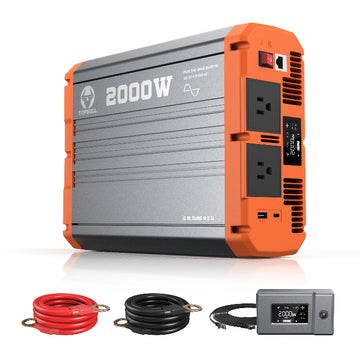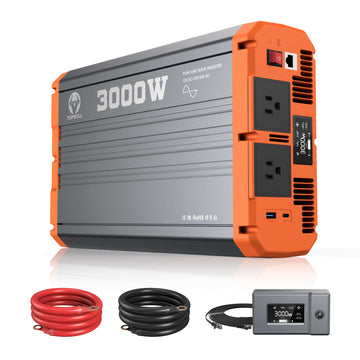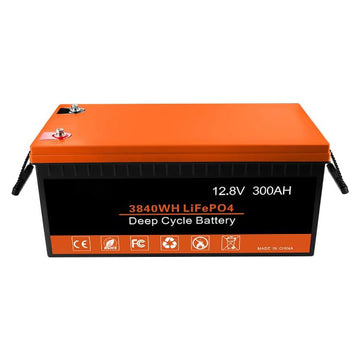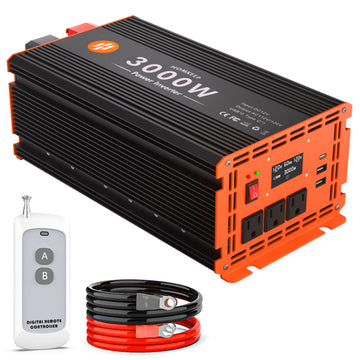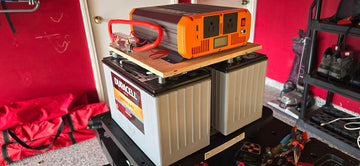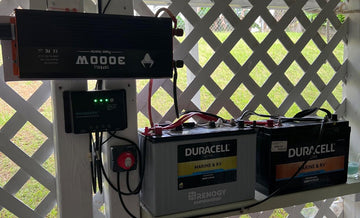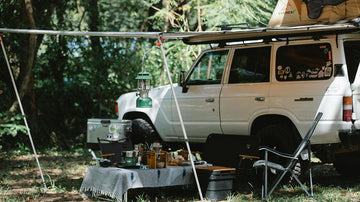A solar charge controller is an essential part of a solar power system that regulates the voltage and current applied to the battery bank based on the state of charge. It protects the battery and extends its life. However, in some cases, one solar charge controller cannot meet the system's power requirements, and multiple solar charge controllers need to be connected. This guide will show you when you can connect more than one controller and guide you through connecting two solar controllers.
Can I Use Multiple Solar Charge Controllers?
The solar charge controller regulates the current sent to the battery based on the battery's state of charge. When the battery is low, the controller sends more current. When the battery is almost full, it reduces the charge current.
Each controller senses and regulates the state of charge of the battery independently, so connecting multiple controllers in parallel will not interfere with each other or cause a loss of efficiency. They can work together to sense the state of charge of the battery and regulate the charge current as required to improve the efficiency and stability of the charge.
Where Multiple Charge Controllers Can Be Used
Increased charge rate
When batteries need to be fully charged more quickly, a single solar charge controller may not be able to provide enough power, and multiple controllers can be connected in parallel to increase charge speed and provide finer charge control.
| Battery | Controller |
| Capacity: 500Wh | Maximum input voltage: 24V |
| Maximum charge rate: 0.5C | Charging voltage: 12V |
| Battery voltage: 12V | Maximum charging current 10A |
For example, the capacity of the above battery is 500Wh, the maximum charging current is 500Wh×0.5=250W, 250W/12V≈20.83A, and the maximum charging current of the solar charge controller is 10A, which is less than the maximum charging current of 20A. Therefore, by connecting two solar charge controllers in parallel, the charging demand of the battery can be better satisfied and the charging speed can be improved.
Effect of light conditions
The position of the solar panels is usually fixed, whereas the sun is always moving and therefore the position of the shadows can change. If it is difficult to install the panels in a position that completely avoids shading, the best solution is to spread the panels and connect the arrays in different positions to separate charge controllers. If connected to the same controller, a string of panels that is shaded will affect the performance of other panels. By connecting several solar charge controllers in parallel, you can balance the charging efficiency of the system and ensure that the solar energy is maximized under different lighting conditions.
Expanding your solar system
If you wish to expand your solar system, you will need to add more solar panels, which will increase the current of the system. If the capacity requirements of a solar system exceed the handling capacity of a single solar charge controller, several controllers can be connected in parallel to increase the total capacity of the system.
Hybrid solar panels
If you want to expand your solar system but can only find solar panels with different specifications. Different ones may have different voltage and current ratings. Mixing different sizes of solar panels can result in a mismatch in power output, so you need to add the appropriate controllers in parallel to ensure system performance and efficiency. (More options for solar panels)

Benefits of connecting two solar charge controllers
Expanded system capacity: Connecting multiple Solar Charge Controllers allows you to process more solar energy, expanding your solar panels and batteries. It provides the flexibility to adapt to your future growth in energy demand.
Increased flexibility: Multiple controllers increase the flexibility of your system, allowing it to better adapt to different light conditions and load variations, improving the efficiency and performance of your system.
Controllers of different sizes can be connected in parallel to manage different types of solar panels, and each controller can be optimized according to the characteristics of the solar panels connected, improving the performance of the whole system.
Reliability: Controllers connected in parallel operate independently, so even if one fails, the other can continue to operate. This ensures system stability and reliability.

Considering Connecting 2 Controllers to 1 Battery Pack
Multiple controllers and multiple other power sources can charge a single battery bank. Similar to solar panels connected in parallel, multiple solar charge controllers simultaneously charge a single battery bank, where the total current increases while the voltage remains constant.
These parallel chargers operate simultaneously and the total charge current received by the battery is equal to the sum of the current output from each charge controller. However, it is important to ensure that the charge controllers are compatible with the batteries and with each other to avoid potential problems or damage.
Before connecting two or more charge controllers to the same battery pack, it is important to note the following:
Voltage and current matching
Ensure that the output voltage and current levels of the charge controller match the specifications of the battery pack. The voltages and currents should be similar between the different controllers, otherwise, they will reach the absorbing/floating state at different times. The combined charge current should be less than the maximum charge current of the battery.
Maximum battery charge current = battery capacity x maximum charge rate
Consistency of controller settings
Ensure that the settings and parameters of each connected solar charge controller are consistent, including charge current, charge voltage limits, etc. Different settings can cause conflicts between controllers. If the controller has an automatic equalization function, make sure it is switched off. Automatic equalization may not be synchronized across multiple controllers and will continue to generate High Voltage Disconnect (HVD) alarms for charge controllers that do not equalize within a specified time.
Steps to Wire Two Solar Charge Controllers
Step 1: Getting ready to work
Confirm compatibility: Ensure that the connected solar controller is compatible with the solar panels and batteries and can work together.
Disconnect the system: Make sure the system is disconnected from the power source before connecting or adjusting any electrical components to ensure safety. Note: All circuits must be de-energized before any wiring is completed.
Step 2: Electrical connections
Connect the batteries: Connect all solar charge controllers to the same battery bank. Connect the positive pole of the controller to the positive pole of the battery and the negative pole to the negative pole. Make sure that each controller is properly connected to the battery and that the polarity is correct.
Connect the solar panels: Connect each solar charge controller to the pair of PV arrays.
Connect the solar charge controllers in parallel: Connect the output terminals (positive and negative) of each regulator in parallel to a central point. This will combine the outputs of all the controllers into a single output.
Step 3: Communication settings
Connect the communication lines: If the charge controllers support communication functions (e.g. RS485 or Wi-Fi), connect the communication lines between the controllers so that they can communicate with each other and coordinate their work. The controller with the lowest communication code is designated as the master controller. In parallel operation, if the master controller fails, the system will automatically switch to the next controller with a higher code value, which will become the new master controller.
Set parameters: Set appropriate parameters in each controller, such as the Maximum Power Point Tracking (MPPT) algorithm and charging mode.
Step 4: Test and tune
Start the system: Start the system and verify that each controller is working properly.
Monitor power output: Monitor the power output of each solar panel in the system to ensure that each controller is effectively managing the charging process.
Adjust parameters: If necessary, adjust the parameters of each charge controller to optimize the performance and efficiency of the system.

Precautions and Safety Measures
- Make secure connections during operation and ensure that output terminals are securely connected to avoid poor contact or short circuits.
- Use appropriate cables, connectors, and fuses to ensure electrical integrity and to prevent overcurrent and short circuits.
- Monitor the operation of the system regularly to ensure that it is working properly and that no abnormalities are occurring.
- Have a contingency plan for controller failure, including a backup controller or backup charging solution, to ensure that problems can be dealt with promptly if they occur.
Connecting two solar charge controllers increases the capacity and reliability of your solar system, which in turn improves scalability and redundancy. By familiarising yourself with the process and following a step-by-step guide, you can ensure a smooth installation. Always prioritize safety and consult the manufacturer's guidelines for specific requirements.
TOPBULL is committed to continuous innovation in pursuit of a cleaner, greener tomorrow. We offer a wide range of products, including top-of-the-range solar controllers, to ensure that your solar system achieves optimum performance and efficiency.
If you are interested in any of our products, please contact us for more information!

